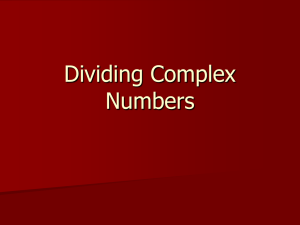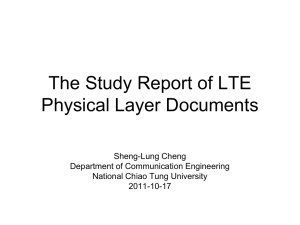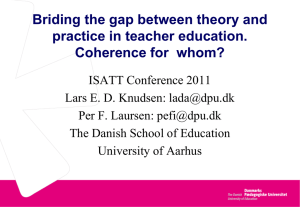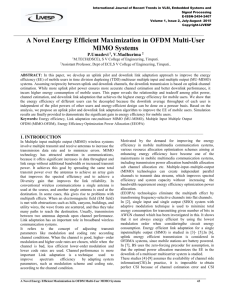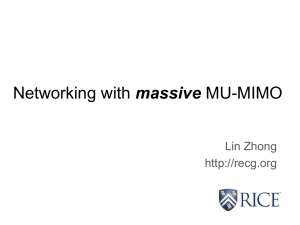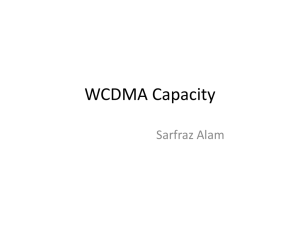Practical Performance of MU-MIMO Precoding in Many
advertisement
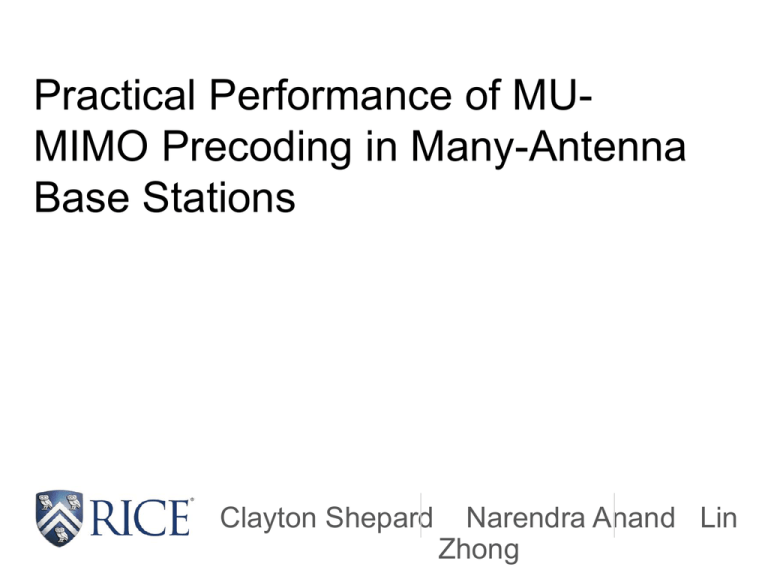
Practical Performance of MUMIMO Precoding in Many-Antenna Base Stations Clayton Shepard Narendra Anand Lin Zhong Background: Many-Antennas • More antennas = more capacity • Traditional approaches don’t scale 2 Background: Beamforming = Destructive Interference Constructive Interference ? = 3 Background: Channel Estimation Due tothe environment andreceiver terminalto Path Effects (Walls) Align phases at the mobility estimation has to occur ensure constructive interference quickly and periodically + BS = + 4 Background: Channel Estimation Multiple users have to send pilots orthogonally BS 5 Frame Structure • Time Division Duplex (TDD) – Uplink and Downlink use the same channel estimates (Still Retrospective) Coherence Time Channel Estimation CE Uplink Comp Downlink Retrospectively Apply Uplink CE … … Pipeline Uplink Computational Overhead 6 Downlink is Limiting Factor! Background: Multi-User Beamforming 8 Background: Multi-User Beamforming 9 Background: Zero-forcing 10 Background: Zero-forcing 11 Background: Zero-forcing 12 Background: Scaling Up Conjugate 13 Background: Scaling Up Conjugate 14 Background: Scaling Up Conjugate 15 Background: Scaling Up Conjugate 16 Conjugate vs. Zero-forcing • Negligible Processing • O(M•K2) • Completely Distributed • Centralized • Substantial Overhead • No Latency Overhead • Poor Spectral Efficiency • Good Spectral Efficiency 17 Under what scenarios, if any, does conjugate precoding outperform zeroforcing? Performance Factors • Environmental – Complex, and constantly changing • Design – Straightforward and Static 19 Performance Factors • Environmental – Channel Coherence – Precoder Spectral Efficiency • Design – Number of Antennas – Hardware Capability 20 Environmental Factor: Channel Coherence • Coherence Time – Increases frequency of channel estimation • Coherence Bandwidth – Increases coherence bandwidth 21 Env. Factor: Precoder Spectral Efficiency • Real-world performance, neglecting overhead • Performance Depends on: – – – – User Orthogonality Propagation Effects Noise Interference • Can be modeled, but impossible to capture everything 22 23 Design Factor: Number of Antennas • Number of Base Station Antennas (M) – Increases amount of computation • Number of User Antennas (K) – Increases channel estimation and computation 24 Design Factor: Hardware Capability • Conjugate has negligible computational cost • Zero-forcing requires: – Bi-Directional Data Transport – Large Matrix Inversions 25 Zero-forcing Hardware Factors • Channel Bandwidth • Inversion Latency • Quantization • Data Transport – Switching Latency – Throughput 26 Performance Model 27 Conjugate vs. Zero-forcing Without Considering Computation CE Comp Transmit 29 Spectral Efficiency vs. # of BS antennas Spectral Efficiency (bps/Hz) K = 15 # of Base Station Antennas (M) 30 Spectral Efficiency vs. # of Users Spectral Efficiency (bps/Hz) M = 64 # of Users (K) 31 Considering Computation CE Comp Transmit 32 M = 64 K = 15 80 Achieved Capacity Capacity (bps/Hz) (bps/Hz) Achieved Conjugate 60 40 20 0 -4 10 -3 -2 10 10 CoherenceTime Time Coherence (s) -1 10 (s) Zeroforcing with various hardware 33 Performance vs. # of Users M = 64 Ct = 30 ms Achieved (bps/Hz) Capacity (bps/Hz) Achieved Capacity 35 30 25 20 15 10 Zero-Forcing Conjugate 5 0 2 4 6 8 10 # of Users (K) Number of Users 12 14 34 Max Multiplexing Gain vs. # of Users M = 200 Ct = 30 ms 140 ZF-Super ZF-Cluster ZF-High ZF-Mid ZF-Low Conjugate (γ · K) Gain Multiplexing Multiplexing Gain ( * K) 120 100 80 60 X: 75 Y: 46.86 X: 89 Y: 52.82 X: 58 Y: 32.39 40 X: 36 Y: 17.27 20 X: 4 Y: 1.253 0 0 20 40 80 60 Number of Users (K) # of Users (K) 100 120 140 35 Applicability • Guide Base Station Design – Refine model for your implementation • Enables adaptive precoding 36 Ramifications More Antennas Faster or Higher MobilityProcessing Zero-forcing 1 GHz Adaptive Precoding Conjugate 10 GHz Conclusions • Accurate model of real-world precoding performance – Separates unpredictable environmental factors from deterministic design • Conjugate can outperform zerforcing • Useful for guiding design and enabling adaptive http://argos.rice.edu 38 precoding Questions? http://argos.rice.edu Frame Pipelining Schemes Coherence Time All Downlink CE Comp Downlink CE Comp Coherence Time All Uplink CE Downlink CE … … CE … Coherence Time Uplink (Not to Scale) Coherence Time Optimal CE Uplink Comp Downlink Uplink CE … … 40

